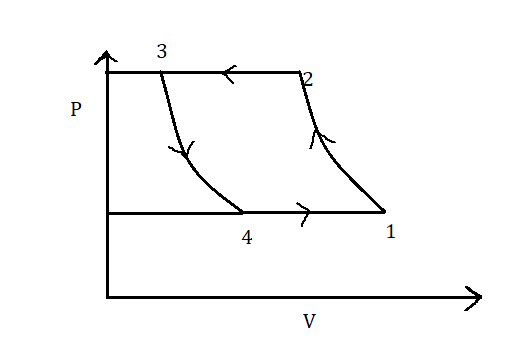
What is the Reverse Brayton Cycle?
Answer
217.8k+ views
Hint: Brayton cycle is a thermodynamic cycle that helps us to describe the process of a heat engine which is having air or gas as its working fluid. It is used for the piston compressor and piston expander. The baryon cycle that flows in the reverse direction is known as the Reverse Brayton cycle. The example of the Reverse Brayton Cycle is the Brayton Refrigeration cycle.
Complete step by step solution:
The Reverse Brayton cycle is a thermodynamic process. In this process, the Bayron cycle is driven in the opposite direction and is known as the Reverse Baryton number. The heat is moved from the colder part to the hotter part of the body.
Its main purpose is to move the heat from the colder part of the body to the hotter part rather than produce work. As we know that according to the Second law of thermodynamics, we cannot move heat spontaneously from the colder part to the hotter part of the body without any external work acting on the system. To produce the flow from the colder part to the hotter part we need to use force by external work and by using these methods the heat pump and refrigerators accomplish.
There are four types of processes that occur in the Reverse Brayton Cycle. The graphs are shown below;

Figure: Reverse Brayton Cycle.
1. Reverse, adiabatic compression in 1-2.
2. Reverse, isobaric heat rejection in 2-3.
3. Reverse, adiabatic expansion in 3-4.
4. Reverse, isobaric heat absorption 4-1.
Note:The Reverse Brayton cycle is used in the refrigeration. It is also known as the Bell Coleman Cycle. It is the reverse flow of heat in the Baryon cycle. Do not confuse the Baryon cycle and the Reverse Baryon cycle.
Complete step by step solution:
The Reverse Brayton cycle is a thermodynamic process. In this process, the Bayron cycle is driven in the opposite direction and is known as the Reverse Baryton number. The heat is moved from the colder part to the hotter part of the body.
Its main purpose is to move the heat from the colder part of the body to the hotter part rather than produce work. As we know that according to the Second law of thermodynamics, we cannot move heat spontaneously from the colder part to the hotter part of the body without any external work acting on the system. To produce the flow from the colder part to the hotter part we need to use force by external work and by using these methods the heat pump and refrigerators accomplish.
There are four types of processes that occur in the Reverse Brayton Cycle. The graphs are shown below;

Figure: Reverse Brayton Cycle.
1. Reverse, adiabatic compression in 1-2.
2. Reverse, isobaric heat rejection in 2-3.
3. Reverse, adiabatic expansion in 3-4.
4. Reverse, isobaric heat absorption 4-1.
Note:The Reverse Brayton cycle is used in the refrigeration. It is also known as the Bell Coleman Cycle. It is the reverse flow of heat in the Baryon cycle. Do not confuse the Baryon cycle and the Reverse Baryon cycle.
Recently Updated Pages
Elastic Collision in Two Dimensions Explained Simply

Elastic Collisions in One Dimension Explained

Electric Field Due to a Uniformly Charged Ring Explained

Electric Field of Infinite Line Charge and Cylinders Explained

Electric Flux and Area Vector Explained Simply

Electric Field of a Charged Spherical Shell Explained

Trending doubts
JEE Main 2026: Application Form Open, Exam Dates, Syllabus, Eligibility & Question Papers

Derivation of Equation of Trajectory Explained for Students

Hybridisation in Chemistry – Concept, Types & Applications

Understanding the Angle of Deviation in a Prism

Understanding Collisions: Types and Examples for Students

How to Convert a Galvanometer into an Ammeter or Voltmeter

Other Pages
JEE Advanced Marks vs Ranks 2025: Understanding Category-wise Qualifying Marks and Previous Year Cut-offs

Units And Measurements Class 11 Physics Chapter 1 CBSE Notes - 2025-26

NCERT Solutions For Class 11 Physics Chapter 8 Mechanical Properties Of Solids

Motion in a Straight Line Class 11 Physics Chapter 2 CBSE Notes - 2025-26

NCERT Solutions for Class 11 Physics Chapter 7 Gravitation 2025-26

Understanding Atomic Structure for Beginners




